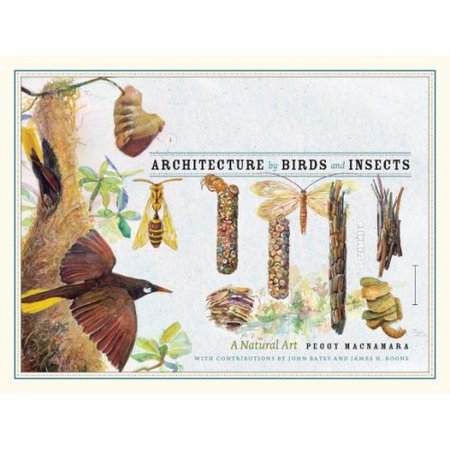December 17, 2008 Categories: Reviews
Architecture by Birds and Insects: A Natural Art
2008. The University of Chicago Press. 141 pp. $25.

“Nests,” writes Peggy Macnamara of the Field Museum of Natural History in Chicago, “are little works of art, built with care and precision, confident and complete.” {xvi} She divides the architectural works of birds and insects into six categories: those made by sewing, weaving, and binding; those made of paper; those made of mud; those made with depressions and mounds; those made by carving wood; and those found close to home.
Macnamara’s 42 exquisite watercolor plates transcend both these categories and the argument whether animals can “really” be architects. What animals can indisputably do is inspire artists, human architects, and maybe even HVAC engineers: “To regulate the temperature of their nest, termites create an air conditioning system. Air enters tunnels built on the side of the nest and escapes through the top.” {88}
Her captions give exact species identifications of her subjects, which range from storks and robins to termites and high-rise spiders. The notes also suggest that nature does create waste (although she does not put it this way). Male house wrens, for instance, build “as many as twelve dummy nests,” only one of which is ever used. Cliff swallows whose nests are severely infested with bloodsucking insects sometimes abandon the nests, leaving their own young to starve. Nature may make a better inspiration than a detailed model. {30, 58-9}
As the architect most like her subjects, Macnamara nominates Auburn University’s Samuel Mockbee, although the work of carpenter ants nesting in an aspen stump also put her in mind of Antonio Gaudi. {xx, 106} Her suggestions for “further reading” include Karl von Frisch’s 1974 classic, Animal Architecture (available in snippet view on Google Book Search), and a much older book I’d never heard of, Homes Without Hands by J. G. Wood, first published in 1866 and available in full on Google Book Search (just beware of some possibly outdated biology). {140-1}
This elegant book is ornamental as well as instructive, and would make a cute last-minute gift if you’re caught short.
#
P.S. For those with special interest in this topic, a day after posting I learned that Norton has three books (which I haven’t seen) delving into it differently: Inspired By Nature: Animals (2009), Inspired by Nature: Minerals (2008), and Inspired by Nature: Plants(2008), all by Alejandro Bahamon and Patricia Pérez, with Alex Campello on the third.
